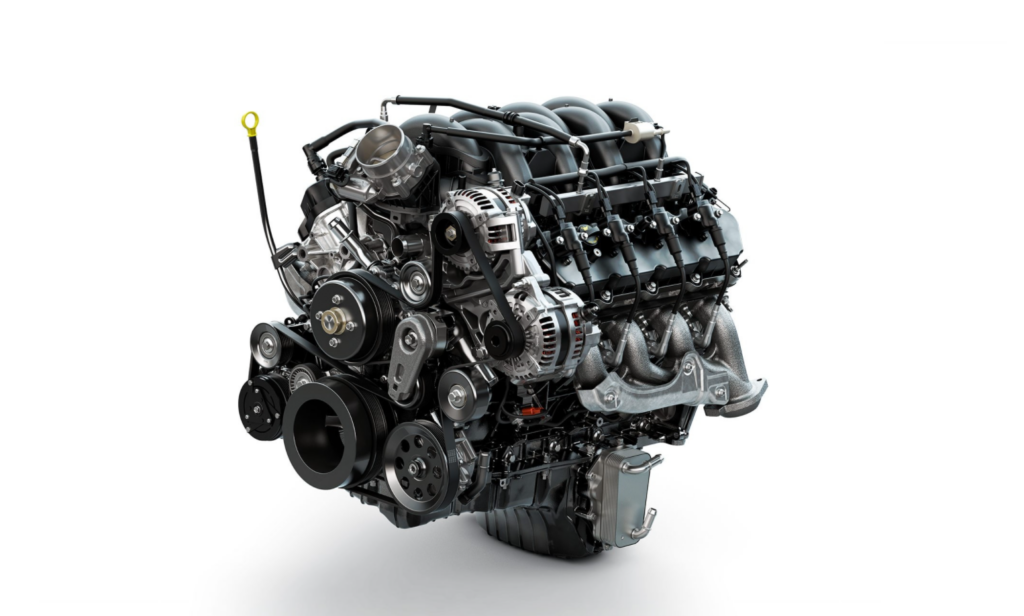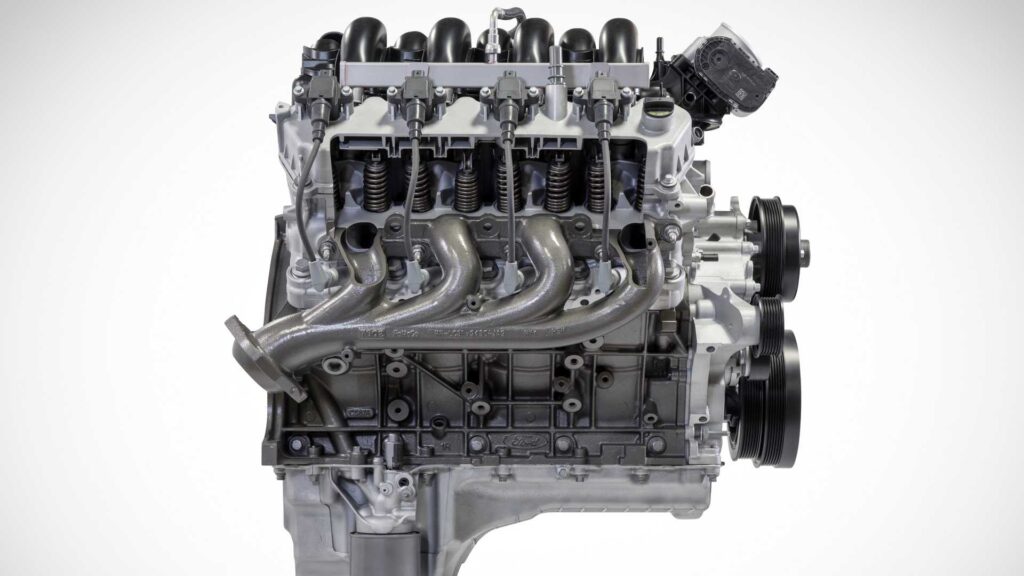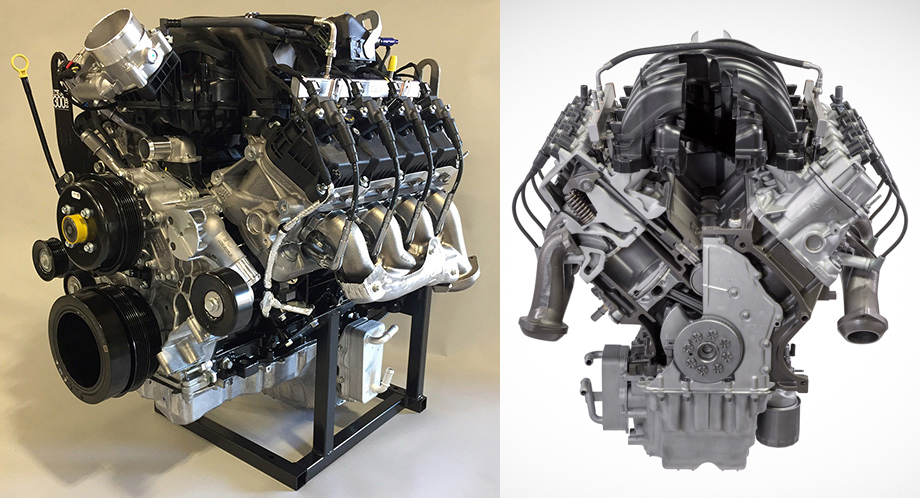If you’re a car enthusiast or a truck lover, you’ve probably heard of the Ford Godzilla engine. This powerful V8 engine has been making waves in the automotive industry for its sheer power and impressive performance. We’re going to explore everything you need to know about the Ford Godzilla engine, from its history to its specifications, and everything in between. So buckle up and get ready to learn about one of the most impressive engines to ever grace the road.
Specs for the Ford Godzilla 7.3 engine
The Ford Godzilla 7.3L engine is used in medium and heavy-duty trucks with a VIN position of 8K. For everything else, it is identified by VIN position 8N. The engine’s displacement is 7.3L or 445 cubic inches with a compression ratio of 10.5:1. At 5,500 rpm, the engine delivers 430 horsepower, and at 4,050 rpm, it produces 475 lb.-ft. of torque in its stock form.

Engine Block
The Ford Godzilla 7.3L engine is utilized in various vehicles, including F-250, F-350, F-550, F-650, F-750, E-350 & E-450. The engine block is made of iron with deep skirt and siamesed cylinders. Its bore diameter is 4.22″, stroke is 3.976″, deck height is 9.650″, and bore spacing is 4.530″. The thrust bearing location is number 3 main, and the main cap style is 4 bolts with 2 lateral cross bolts. Its cam-to-crank centerline is 5.433″, and the bellhousing bolt pattern is 5.0L-4.6L-5.4L.
Rotating Assembly
The Ford Godzilla 7.3L engine’s rotating assembly consists of a hypereutectic aluminum piston with a 1.5mm, 1.2mm, 2.5mm piston style. The connecting rod material is powdered metal with a fractured cap and an external torx head on rod bolts. The connecting rod style is I-Beam, with a length of 6.319″, a wrist pin diameter of 0.990″, and a big end diameter of 2.236″. The crankshaft is made of forged steel with a main journal diameter of 2.660″, a rod journal diameter of 2.086″, and a reluctor count of 58x. It has an eight-bolt mounting flange.
Cylinder head
The Ford Godzilla 7.3L engine’s cylinder head is made of aluminum with a casting number of LH07 T869Q. Its combustion chamber volume is 62.4cc, with a rectangular oval intake port shape and a round exhaust port shape. The intake valve diameter is 2.17″, and the exhaust valve diameter is 1.67″. The cylinder head bolt style is Torque to Yield (TTY) with a 13mm bolt size.
Camshaft
The Ford Godzilla 7.3L engine’s camshaft has a cam duration of 201 (intake) / 212 (exhaust) at 0.050″ and a valve lift of 0.539″ (intake) / 0.595″ (exhaust). It also has variable valve timing (VVT) and a cam journal diameter of 60mm.
Valvetrain
The Ford Godzilla 7.3L engine’s valvetrain consists of hydraulic roller lifters, plastic holder lifter link style, a nitrided axle with a lifter diameter of 0.842″, and five cam journals. The rocker arm mounting style is die-cast with a roller fulcrum and a rocker ratio of 1.8:1. It also has a valve spring style of beehive with a valve angle of 8.8 degrees and a single chain with two separate tensioners for timing chain guide style.
The Ford Godzilla 7.3L engine has an intake manifold made of composite material with port injection and an angled up throttle body. Its throttle body diameter is 80mm, and it has electronic throttle body control. The fuel injector flow is 35 lbs./hr., and it has a USCAR fuel injector connector. The camshaft sensor location is at the front timing cover with the VVT gear, and it has a gerotor variable displacement oil pump that is chain-driven by jackshaft. The engine’s oil capacity is 8 quarts, and its firing order is 1-5-4-8-6-3-7-2. It also has piston cooling jets, weighs 540 lbs., and is 23.5″ wide at the top of the valve covers.
| Specification | Details |
|---|---|
| Engine Type | 7.3-liter V8 |
| Block Material | Cast iron |
| Cylinder Head Type | Aluminum |
| Valvetrain | Pushrod |
| Fuel Delivery | Port fuel injection |
| Horsepower | 430 hp at 5,500 rpm |
| Torque | 475 lb-ft at 4,000 rpm |
| Bore x Stroke | 107.2 mm x 101.0 mm |
| Compression Ratio | 10.5:1 |
| Transmission | 10-speed automatic |
| Towing Capacity | Up to 21,000 pounds |
| Fuel Economy | 15 mpg city/20 mpg highway |
| Emissions Rating | ULEV-70 |
| Warranty | 3 years/36,000 miles basic, 5 years/60,000 miles PT |
| Applications | Ford F-250, F-350 Super Duty trucks (2019-present) |
This engine is a powerhouse, with impressive torque and towing capabilities. It’s ideal for heavy-duty trucks that need to haul heavy loads or navigate off-road terrain. Despite its power, it still delivers decent fuel economy, making it a practical choice for those who need a strong engine but don’t want to sacrifice too much at the pump. The Ford Godzilla 7.3 engine is a solid choice for those who demand the best in power and performance.
Performance of the Ford Godzilla Engine
The performance of the Ford Godzilla engine is nothing short of impressive. It’s one of the most powerful engines in its class, and it can deliver an exceptional driving experience. The engine is capable of hauling heavy loads with ease, and it has plenty of power for off-road adventures. Whether you’re driving on the highway or navigating rough terrain, the Ford Godzilla engine is sure to impress.
Ford Godzilla Engine Towing Capacity: How Much Can It Haul?
The towing capacity of a vehicle with a Ford Godzilla engine will depend on several factors, such as the vehicle’s weight, axle ratio, and transmission type. However, the Ford Godzilla engine is capable of towing significant weight when properly equipped.
The maximum towing capacity for a vehicle with the Ford Godzilla engine varies depending on the specific model and configuration, but it can range from 13,000 to 21,000 pounds. For example, the 2023 Ford F-250 Super Duty with the 7.3L V8 engine has a maximum towing capacity of up to 15,000 pounds when properly equipped with a gooseneck hitch, and the 2023 Ford F-450 Super Duty with the 7.3L V8 engine has a maximum towing capacity of up to 21,200 pounds when properly equipped with a fifth-wheel hitch.
It’s important to note that towing capacity is not the only consideration when choosing a vehicle for towing. Other factors, such as payload capacity and overall vehicle stability, should also be taken into account. Additionally, proper towing equipment, such as a hitch and trailer brakes, is essential for safe and effective towing.
If you’re planning to tow with a vehicle equipped with the Ford Godzilla engine, it’s important to consult the owner’s manual for specific towing capacity and equipment recommendations, and to ensure that the vehicle is properly equipped and maintained for safe towing.
Fuel Economy
As such, it is not the most fuel-efficient engine on the market. However, there are some steps that can be taken to improve fuel economy while still taking advantage of the engine’s performance capabilities. Here is a table that outlines some fuel-saving tips and their potential impact on fuel economy:
| Modification/Tips | Potential Impact on Fuel Economy |
|---|---|
| Regular maintenance (oil changes, air filter replacement, etc.) | Up to 5% |
| Proper tire inflation | Up to 3% |
| Driving at moderate speeds (avoiding excessive idling, aggressive acceleration, and speeding) | Up to 33% |
| Using cruise control on the highway | Up to 7% |
| Removing excess weight from the vehicle | Up to 2% |
| Upgrading to high-efficiency tires | Up to 3% |
| Installing a performance tuner to improve engine efficiency | Up to 10% |
It’s important to note that the potential impact on fuel economy listed above is based on estimates and will vary depending on a variety of factors, such as driving conditions and vehicle load. Additionally, some modifications, such as a performance tuner, may improve fuel economy while also increasing engine power and performance.
If you’re looking to improve fuel economy for your Ford Godzilla engine, it’s important to focus on reducing excess weight, driving at moderate speeds, and maintaining proper tire inflation. Additionally, regular maintenance and the use of high-efficiency parts (such as tires) can also help to improve fuel economy.
Ford Godzilla 7.3 Engine oil specs
Proper oil maintenance is critical for ensuring the longevity and performance of your Ford Godzilla engine. Here is a table that outlines the recommended oil specifications, intervals, capacity, and estimated costs for the Ford Godzilla engine:
| Oil Specification | Interval | Capacity | Estimated Cost |
|---|---|---|---|
| SAE 0W-20 or SAE 5W-20 | Every 7,500 miles or 6 months, whichever comes first | 7 quarts | $50-$100 |
| Motorcraft SAE 5W-30 Full Synthetic | Every 7,500 miles or 6 months, whichever comes first | 7 quarts | $50-$100 |
It’s important to note that the costs listed above are estimates and may vary depending on a variety of factors, such as the specific oil used and the location of the service. Additionally, it’s important to use only oils that meet the Ford specification for the engine to ensure proper performance and longevity.
Engine Maintenance
Proper maintenance is essential for ensuring the longevity and performance of your Ford Godzilla engine. Here is a table that outlines the recommended maintenance intervals and estimated costs for the Ford Godzilla engine:
| Maintenance Item | Interval | Estimated Cost |
|---|---|---|
| Oil and filter change | Every 7,500 miles or 6 months, whichever comes first | $50-$100 |
| Air filter replacement | Every 30,000 miles or as needed | $20-$50 |
| Fuel filter replacement | Every 30,000 miles or as needed | $50-$100 |
| Spark plug replacement | Every 100,000 miles or as needed | $100-$300 |
| Transmission fluid and filter change | Every 30,000-60,000 miles or as needed | $150-$300 |
| Coolant flush and refill | Every 100,000 miles or as needed | $100-$200 |
| Timing belt replacement | Every 100,000 miles or as needed | $500-$1,000 |
| Brake pad replacement | Every 25,000-50,000 miles or as needed | $100-$300 |
It’s important to note that the costs listed above are estimates and may vary depending on a variety of factors, such as the specific parts used and the location of the service. Additionally, some maintenance items may be more urgent than others depending on the age and mileage of the vehicle.

Reliability
The Ford Godzilla engine is a relatively new engine, introduced in 2020, and as such, there is not yet a significant amount of data on its long-term reliability. However, initial reports indicate that it is a robust and durable engine, designed to withstand heavy use and abuse.
The Godzilla engine is a 7.3-liter V8 engine that produces 430 horsepower and 475 lb-ft of torque. It is designed to be a workhorse engine, capable of handling heavy loads and towing with ease. It is also built to be durable, with features such as a cast-iron block and cylinder heads, a forged steel crankshaft, and piston cooling jets.
Overall, the Ford Godzilla engine appears to be a reliable and durable engine, but it is still too early to make definitive statements about its long-term reliability. Regular maintenance and proper care will be essential to ensure its longevity.
Ford Godzilla 7.3 Common Problems: Causes and Solutions
If you are a truck enthusiast, you might be familiar with Ford’s new V8 engine, the 7.3L Godzilla. This engine was introduced in 2020 and quickly gained popularity among truck owners. However, like any other engine, the Ford Godzilla 7.3L has its fair share of common problems that can affect its performance and durability.
1. Rough Idling
One of the most common problems with the Ford Godzilla 7.3L engine is rough idling. The engine might idle roughly or stall when coming to a stop. This problem can be caused by a faulty idle air control valve or a dirty throttle body.
Solution:
Cleaning or replacing the idle air control valve and throttle body can solve the rough idling problem. Also, checking the vacuum hoses and PCV valve can prevent rough idling.
2. Engine Misfire
Another common problem with the Ford Godzilla 7.3L engine is engine misfire. The engine might misfire or hesitate when accelerating, leading to a loss of power and performance.
Solution:
Replacing the faulty spark plugs, ignition coils, or fuel injectors can solve the engine misfire problem. Also, checking the fuel pressure and fuel system can prevent engine misfire.
3. Excessive Oil Consumption
Some truck owners have reported excessive oil consumption with the Ford Godzilla 7.3L engine. The engine might burn or leak oil, leading to low oil levels and engine damage.
Solution:
Replacing the faulty valve seals or piston rings can solve the excessive oil consumption problem. Also, checking the PCV valve and the engine’s breather system can prevent oil consumption.
4. Transmission Shifting Issues
The Ford Godzilla 7.3L engine is often paired with the 10-speed automatic transmission, which might experience shifting issues. The transmission might shift erratically or slip between gears.
Solution:
Replacing the faulty transmission fluid or the transmission control module can solve the shifting issues. Also, checking the transmission cooler and the cooling system can prevent transmission issues.

Ford Godzilla Engine Tuning: Get More Power
Modifying an engine for more power can be a complex process that requires careful consideration and expertise. There are a variety of aftermarket parts and tuning options available for the Ford Godzilla engine, but it’s important to keep in mind that some modifications may void your warranty and could potentially damage your engine if not done correctly.
Here is a table that outlines some common modifications and their estimated costs and potential horsepower gains for the Ford Godzilla engine:
| Modification | Cost | Estimated HP Gain |
|---|---|---|
| Cold air intake | $250-$500 | Up to 10 HP |
| Performance exhaust system | $500-$1,000 | Up to 15 HP |
| Performance camshaft | $500-$1,500 | Up to 30 HP |
| Ported and polished cylinder heads | $1,000-$2,500 | Up to 50 HP |
| Forced induction (supercharger/turbocharger) | $5,000-$10,000+ | Up to 200+ HP |
It’s important to note that the horsepower gains listed above are estimates and will vary based on the specific parts used and the quality of the installation. Additionally, some modifications may require additional supporting modifications, such as upgraded fuel systems, to ensure proper operation.
Cost of a Godzilla 7.3L engine swap
The cost of a Ford Godzilla 7.3L engine swap can vary depending on several factors such as the make and model of the vehicle, labor costs, and the engine’s condition. Generally, the cost of the engine alone can range from $8,000 to $10,000, while installation costs can range from $2,500 to $5,000. Additional costs such as custom fabrication, exhaust modifications, and transmission upgrades may also add to the total cost.
It is essential to consider the overall cost of the swap, including any necessary upgrades or modifications, before undertaking such a project. Some car enthusiasts opt for a DIY approach to save on labor costs, but this can be a complex and challenging task that requires specialized tools and knowledge.
Ultimately, the total cost of a Ford Godzilla 7.3L engine swap will depend on several factors, including the specific requirements of the project. It is crucial to work with a reputable and experienced mechanic or performance shop to ensure that the swap is done correctly and to minimize any potential issues down the road.
Price
Estimated prices for a used, remanufactured, and new Ford Godzilla 7.3L engine:
| Engine Type | Price Range |
|---|---|
| Used Engine | $5,000 – $8,000 |
| Remanufactured | $8,000 – $12,000 |
| New Engine | $12,000 – $15,000 |
A used Ford Godzilla 7.3L engine can cost anywhere from $5,000 to $8,000, depending on factors such as mileage, condition, and the seller. It is crucial to thoroughly inspect a used engine before purchasing to ensure that it is in good working condition.
A remanufactured Ford Godzilla 7.3L engine can range from $8,000 to $12,000, depending on the supplier and the level of refurbishment performed. A remanufactured engine typically comes with a warranty and has undergone a thorough inspection and rebuild process, making it a reliable option.
A new Ford Godzilla 7.3L engine can cost anywhere from $12,000 to $15,000, depending on the supplier and the engine’s specifications. New engines come with a warranty and have not been used previously, making them the most reliable option.
0 Comments